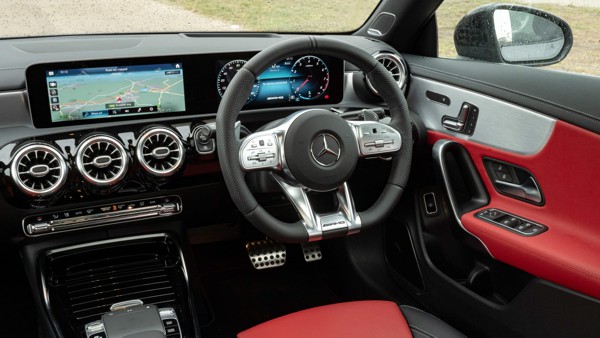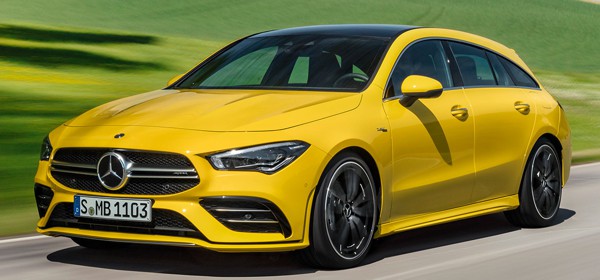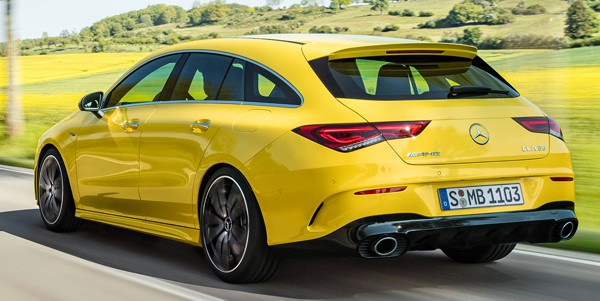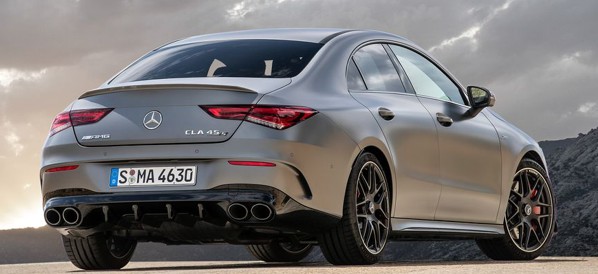Published
on 11
Mar 2020
|
All rights reserved.
|
|

|
|
A
good-looking, value-packed car with a 3-pointed star badge is hard to
resist...
|
|
7 years ago, Mercedes found
a new way to break into the compact car market in the United States and
Asia: CLA-class. While the A-class hatchback is hopeless to do so, a
coupe-style 4-door saloon sounds far more graceful to American and
Asian buyers. They don’t necessarily chase for rear-drive dynamics, but
a good-looking, value-packed car with a 3-pointed star badge is hard to
resist. Build this car on the MFA front-wheel-drive architecture of the
A-class, B-class and GLA-class will spread costs and keep its prices
affordable. Most important, from its rakish look no one would realize
its cheap basis. In this way, the first generation CLA-class captured
750,000 sales in its 5 and a half-years lifespan, incredible for a
niche model.
The second generation CLA, codenamed C118, follows the footprints of
its predecessor to be a "4-door coupe". It is supposed to be more
premium than the A-class, but it is still reasonably priced, costing a
premium of £2000 only. It retains a swoopy roofline and slim
frameless windows, but the details have been refined. The front end
shows family resemblance to the larger CLS-class, thanks to slimmer
headlights and a reshaped front grille. Actually, the whole car looks
rather like a 70-percent scale CLS. The sides have been simplified,
removing the swoopy crease line that made the old car so special. The
taillights get slimmer, too, and the boot lid gets a wider opening.
However, drag coefficient is unchanged. The sleekest model has a Cd of
0.23, still one of the lowest in production.

|
|
Dynamics
are much improved from the old CLA, though still fail to be ranked
among the class leaders.
|
|
The C118 has grown 58mm longer and a significant 53mm wider, while its
wheelbase has been stretched to 2729mm to match the A-class with which
it shares the MFA2 platform. Contrary to perception, its roof is
only 10mm lower than that of the A-class hatchback, although its high
curvature
does hamper rear headroom more seriously. The car is also wider than
its hatchback sibling, boosting front and rear track by 8mm and 27mm,
respectively, in pursuit of better handling. Trunk space grows to 460
liters, more than even the A-class sedan (420 liters), thanks to the
extra length of its rear overhang.
The interior is predictably more cramped. Driver comfort is almost
unaltered, as headroom is virtually the same and he faces exactly the
same controls. The rear seat suffers the most loss, as headroom is
slashed by a massive 52mm compared with the A-class hatchback (that’s 2
inches),
rendering its use to children, short adults or for very short trips.
Slimmer windows hamper outward visibility as well as the sense of
spaciousness. As in the A-class, twin-10.25-inch TFT screens span the
dashboard, displaying crisped graphics and delivering a sophistication
few others could match. The MBUX user interface is powerful and
versatile, allowing you to access via a pair of touchpads on the
steering wheel, the touchscreen, trackpad on the transmission tunnel,
gesture and voice recognition. The infotainment technology and interior
build quality are as good as you get in this class.

|
|
Same
environment as the A-class up front, but the rear loses 2 inches of
headroom.
|
|
While the A-class has multi-link rear axle reserved for models from
A250 upward, the CLA has it fitted standard across the range. Its
suspension tuning is sportier, no matter springs, dampers or anti-roll
bars, so that the car corners flatter. On the downside, the ride gets
busier. On rougher surfaces it feels quite harsh and may run out of
suspension travel more easily. It is not quite as harsh as the old CLA,
of course, but still rest at the hardcore side of the class. Opt for
adaptive dampers and the car feels more at home on fast B-roads, but it
still struggles on sharp bumps that you won't notice on a VW Golf R.
Likewise, broken pavement in town can easily unsettle its refinement.
The CLA also suffers from more road noise than its hatchback sibling.
Its steering, roadholding and agility are decent, if not better than
the A-class. CLA35 AMG has additional reinforcement around the engine
bay and front suspension like its A35 sibling. Its handling is more
competent and
entertaining than lesser CLAs, of course, but fails to rise above the
competition.
The base CLA180 and CLA200 run a 1.3-liter four-cylinder turbo with
136hp and 163hp, respectively. They are slow and noisy at rev thus
better to
be avoided. CLA250 is the mainstream choice. Its 2-liter engine
produces 224hp and manages to do 0-60 in 6 seconds. However, this
engine is not the sweetest out there, not very willing to rev and not
very refined either. The 7-speed DCT remains a weak point. In auto mode
its gearshift is inconsistent and sometimes hesitant. In manual mode it
will automatically upshift before reaching the redline, discouraging a
spirited mood. Comparatively, the newer 8-speed DCT on the CLA220d
feels a lot more refined. The 190hp diesel engine is also refined yet
gusty, providing a long-legged performance that suits the CLA very
well. At the top, CLA35 sounds powerful with a rating of 306hp, but its
power band is narrow and its sound is dull. Moreover, it doesn’t
feel as quick as the 0-60 mph time of 4.7 seconds suggested.

|
|
What
if we put the beautiful packaging of CLA on the underpinnings of BMW
2-Series Gran Coupe? That must be a perfect product.
|
|
All these flaws prevent the CLA from being praised as a
driver’s car. Meanwhile, it also lacks the refinement and comfort to
feel a truly premium product. Frankly, having known the A-class
already, you wouldn’t be shocked to hear the same story. Dynamically,
the new CLA is undeniably much improved from its direct predecessor,
which admittedly drove quite badly. It just lacks the polish to elevate
to the list of class leaders.
What we feel sorry about is the lost opportunity. The CLA has a
gorgeous exterior and one of the most desirable interiors. It should
have been made a more premium, more refined alternative to the A-class
sedan rather than a sportier and less refined one. In other words, like
what BMW has done to the 2-Series Gran Coupe. Somehow, BMW softened a
car that needs to be sharpened, whereas Mercedes did the contrary.
Think about this, what if we put the beautiful packaging of the CLA on
the underpinnings of an M235i Gran Coupe? That must be a perfect
product.

|
|
Shooting
Brake is more attractive than sedan, aesthetically and practically.
|
|
Since we cannot stand the look of that BMW, right now the
best choice among the compact premium 4-door coupe class – what a niche
class! – is the Shooting Brake version of the CLA. Don’t call it an
estate or wagon, because it looks even more attractive than the 4-door
model. The banana-shape side glass combines with a curvy waist
line to draw your attention away from the flat roof line. The effect is
far more convincing than what Kia tried on the Proceed, and no less
dramatic than the last generation CLA Shooting Brake. In terms of
practicality, it is far superior than the 4-door. The boot measures 505
liters in standard form, expanding to 1370 liters with rear seats down.
Most important, rear passengers enjoy 47 mm more headroom, so taller
adults are no longer prohibited from the rear seats. It carries just 25
more kilograms and
adds a bit drag, losing little performance. In short, it is more
stylish and more practical than the sedan. Sometimes you can have your
cake and eat it!
|
Verdict:    |
Published
on 11
Mar 2020
|
All rights reserved.
|
|
AMG CLA45
|
|

|
|
Combines
performance and handling with 4-seat accommodation and a desirable
coupe look.
|
|
As
we have seen recently, the new Mercedes-AMG A45 is a remarkable super
hatchback, one that combines huge performance, expert control and a
versatile personality. How about its sister car CLA45?
The conversion from lesser CLA-class models to CLA45 is more or less
the same as the case of A45, since both cars share nearly the same
modified parts. First of all is the M139 engine, the world’s most
powerful production 4-cylinder. From just 2.0 liters of capacity, it
manages to squeeze out 421 crazy horsepower on the S model, accompanied
with 369 pound-foot of torque, thanks to a roller-bearing twin-scroll
turbo, dual-mode injection, a stiff block and heavy duty cooling
systems, among other technologies. Moreover, unlike conventional
turbocharging, it has its torque curve shaped to peak at 5000-5250 rpm,
resulting in a linear power delivery that encourages the driver to
access its top end to get the best of it. It sounds good, too, at least
for a four-cylinder engine.
While the A45 S gets from rest to 60 mph in 3.8 seconds, the CLA45 S
needs an extra tenth because it is 40 kg heavier, courtesy of its extra
length. Both cars have their top speed limited to 168 mph, although I
suspect the more slippery body of CLA could ultimately achieve a higher
top speed if derestricted. Its AMG aero kits generate positive
downforce, yet the drag coefficient is only 0.31.
Chassis is what separates the CLA45 from its hatchback sister. It has
wider front and rear track, and the suspension setup is stiffer as
well. In addition to those 10mm-wider rubbers, theoretically it should
beat the A45 in handling. Nevertheless, in the real world the opposite
is found. Owing to its extra weight and longer tail, hence a higher
polar moment of inertia, the CLA45 steers not quite as responsively.
The turn-in is less sharp. The tail is a tad more resistant to
oversteer, but once it is pushed to go wide, the oversteer is more
pronounced. In short, the A45 feels lighter, more compact and more
agile, which is not surprising.

|
|
Driving
dynamics are overshadowed by the lighter and more compact A45.
|
|
However,
the difference is rather small. Since the clever 4WD system with
twin-multiplate clutch works seamlessly to adjust power between the
rear wheels, the CLA45 still able to keep its under- and oversteer in
check. The result is a tidy control no matter how hard you attack
corner. You can induce more oversteer in Sport+ and Drift mode, but the
inability of pure rear-wheel drive means it will never power slide as
massively and sustainably as an AMG GT 4-door.
The chassis reinforcement that it shares with the A45, such as an
aluminum plate added underneath the engine, extra bracings around the
front chassis, rigidly mounted subframes and steering rack, work well
to deliver an iron-fisted body control. It corners with precious little
roll, noticeably less than its hatchback sister, thanks to that stiffer
suspension and wider tracks. Braking is powerful. The steering seems
a little lighter than the A45’s, but still gifted with high precision,
and it weighs up reassuringly if you leave it in Sport+ mode (or use
Individual mode to set it to the maximum).
Less great is ride comfort. The A45 is already on the firm side of
acceptable range. The CLA45 is stiffer still, so it could be quite
harsh on poorer surfaces. The beefier rubbers also make more noise on
cruising, so long-distance comfort is not its strength.
Starting at £52,000, the CLA45 S is marginally more expensive
than the A45 S. Some might see it good value considering its more
stylish look and a more premium image. Some see otherwise due to its
slightly less agile handling, poorer ride and marginally lower
performance. A BMW M2 Competition is just as fast and more fun to
drive, and it makes you wondering why pay the same money for a
four-cylinder engine. However, the CLA45 is unique in the class, as it
combines performance and handling with 4-seat accommodation and a
desirable coupe look.
|
Verdict:     |
|